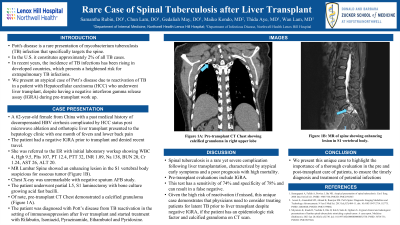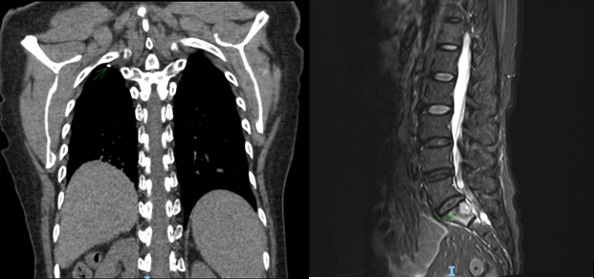Monday Poster Session
Category: Liver
P3116 - Rare Case of Spinal Tuberculosis After Liver Transplant
Monday, October 28, 2024
10:30 AM - 4:00 PM ET
Location: Exhibit Hall E

Has Audio

Samantha Rubin, DO
Lenox Hill Hospital, Northwell Health
New York, NY
Presenting Author(s)
Samantha Rubin, DO1, Chun Lam, DO1, Gedaliah May, MS, DO1, Maiko Kondo, MD, MS.2, Thida Aye, MD, MPH.2, Wan Lam, MD2
1Lenox Hill Hospital, Northwell Health, New York, NY; 2Lenox Hill, Northwell Health, New York, NY
Introduction: Pott's disease is a rare presentation of mycobacterium tuberculosis (TB) infection that specifically targets the spine. In the U.S. it constitutes approximately 2% of all TB cases. In recent years, the incidence of TB infections has been rising in developed countries due to international migration. This presents a heightened risk for extrapulmonary TB infections, particularly among immunocompromised individuals. We present an atypical case of Pott’s disease due to reactivation of TB in a patient with Hepatocellular carcinoma (HCC) who underwent liver transplant, despite having a negative interferon gamma release assay (IGRA) during pre-transplant work up.
Case Description/Methods: A 62-year-old female from China with past medical history of decompensated HBV cirrhosis complicated by HCC status post microwave ablation and orthotopic liver transplant presented to the hepatology clinic with one month of fevers and lower back pain. The patient had a negative IGRA prior to transplant and denied recent travel. She was referred to the ER with initial laboratory workup showing WBC 4, Hgb 9.5, Plts 107, PT 12.4, PTT 32, INR 1.09, Na 138, BUN 20, Cr 1.24, AST 26, ALT 20. MRI of the lumber spine showed an enhancing lesion in the S1 vertebral body suspicious for osseous tumor (figure 1). Chest X-ray was unremarkable with negative sputum AFB study. The patient underwent partial L5, S1 laminectomy with bone culture growing acid fast bacilli. Of note, pre-transplant CT Chest demonstrated a calcified granuloma (figure 1). The patient was diagnosed with Pott’s disease from TB reactivation in the setting of immunosuppression after liver transplant and started treatment with Rifabutin, Isoniazid, Pyrazinamide, Ethambutol and Pyridoxine.
Discussion: Spinal tuberculosis is a rare yet severe complication following liver transplantation, characterized by atypical early symptoms and a poor prognosis with high mortality. Pre-transplant evaluations include IGRA. This test has a sensitivity of 74% and specificity of 78% and can result in a false negative. Given the high risk of reactivation if missed, this unique case demonstrates that physicians need to consider treating patients for latent TB prior to liver transplant despite negative IGRA, if the patient has an epidemiologic risk factor and calcified granuloma on CT scan. We present this unique case to highlight the importance of a thorough evaluation in the pre and post-transplant care of patients, to ensure the timely diagnosis and treatment of potential infections.

Disclosures:
Samantha Rubin, DO1, Chun Lam, DO1, Gedaliah May, MS, DO1, Maiko Kondo, MD, MS.2, Thida Aye, MD, MPH.2, Wan Lam, MD2. P3116 - Rare Case of Spinal Tuberculosis After Liver Transplant, ACG 2024 Annual Scientific Meeting Abstracts. Philadelphia, PA: American College of Gastroenterology.
1Lenox Hill Hospital, Northwell Health, New York, NY; 2Lenox Hill, Northwell Health, New York, NY
Introduction: Pott's disease is a rare presentation of mycobacterium tuberculosis (TB) infection that specifically targets the spine. In the U.S. it constitutes approximately 2% of all TB cases. In recent years, the incidence of TB infections has been rising in developed countries due to international migration. This presents a heightened risk for extrapulmonary TB infections, particularly among immunocompromised individuals. We present an atypical case of Pott’s disease due to reactivation of TB in a patient with Hepatocellular carcinoma (HCC) who underwent liver transplant, despite having a negative interferon gamma release assay (IGRA) during pre-transplant work up.
Case Description/Methods: A 62-year-old female from China with past medical history of decompensated HBV cirrhosis complicated by HCC status post microwave ablation and orthotopic liver transplant presented to the hepatology clinic with one month of fevers and lower back pain. The patient had a negative IGRA prior to transplant and denied recent travel. She was referred to the ER with initial laboratory workup showing WBC 4, Hgb 9.5, Plts 107, PT 12.4, PTT 32, INR 1.09, Na 138, BUN 20, Cr 1.24, AST 26, ALT 20. MRI of the lumber spine showed an enhancing lesion in the S1 vertebral body suspicious for osseous tumor (figure 1). Chest X-ray was unremarkable with negative sputum AFB study. The patient underwent partial L5, S1 laminectomy with bone culture growing acid fast bacilli. Of note, pre-transplant CT Chest demonstrated a calcified granuloma (figure 1). The patient was diagnosed with Pott’s disease from TB reactivation in the setting of immunosuppression after liver transplant and started treatment with Rifabutin, Isoniazid, Pyrazinamide, Ethambutol and Pyridoxine.
Discussion: Spinal tuberculosis is a rare yet severe complication following liver transplantation, characterized by atypical early symptoms and a poor prognosis with high mortality. Pre-transplant evaluations include IGRA. This test has a sensitivity of 74% and specificity of 78% and can result in a false negative. Given the high risk of reactivation if missed, this unique case demonstrates that physicians need to consider treating patients for latent TB prior to liver transplant despite negative IGRA, if the patient has an epidemiologic risk factor and calcified granuloma on CT scan. We present this unique case to highlight the importance of a thorough evaluation in the pre and post-transplant care of patients, to ensure the timely diagnosis and treatment of potential infections.

Figure: Pre-transplant CT Chest showing calcified granuloma in right upper lobe; MR of spine showing enhancing lesion in S1 vertebral body.
Disclosures:
Samantha Rubin indicated no relevant financial relationships.
Chun Lam indicated no relevant financial relationships.
Gedaliah May indicated no relevant financial relationships.
Maiko Kondo indicated no relevant financial relationships.
Thida Aye indicated no relevant financial relationships.
Wan Lam indicated no relevant financial relationships.
Samantha Rubin, DO1, Chun Lam, DO1, Gedaliah May, MS, DO1, Maiko Kondo, MD, MS.2, Thida Aye, MD, MPH.2, Wan Lam, MD2. P3116 - Rare Case of Spinal Tuberculosis After Liver Transplant, ACG 2024 Annual Scientific Meeting Abstracts. Philadelphia, PA: American College of Gastroenterology.

